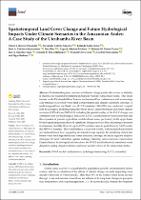Spatiotemporal Land Cover Change and Future Hydrological Impacts Under Climate Scenarios in the Amazonian Andes A Case Study of the Utcubamba River Basin
Fecha de publicación
07-06-2025Autor
Rivera-Fernandez, Abner S
Cotrina-Sanchez, Alexander
Salas López, Rolando
Ríos Ramírez, José Ney
y otros más
Objetivos de desarrollo sostenible
ODS 15 - Vida de ecosistemas terrestres
ODS 16 - Paz, justicia e instituciones sólidas
Tipo
Artículo
Metadatos
Mostrar el registro completo del ítemResumen
Understanding how land use and climate change jointly affect water availability is essential for sustainable planning in tropical Andean–Amazonian basins. This study focuses on the Utcubamba River Basin in northeastern Peru, a data-scarce and socioecologically strategic watershed where land transformation and climate variability converge. A multi-temporal land use/land cover (LULC) analysis (1990–2024) was conducted, coupled with hydrological modeling using the SWAT model under historical and future climate scenarios (SSP2–4.5 and SSP5–8.5), including the spatial overlay of the LULC change concentration with key hydrological indicators. LULC classifications revealed forest loss and the expansion of pasture, agriculture, and shrubland areas, particularly in the upper basin. Hydrological projections showed significant changes in water flow, including reductions in minimum monthly flows by up to 73.9% and increases in peak flows by 14.8% under the SSP5–8.5 scenario. The water balance is expected to shift, with increased percolation and reduced lateral flow, suggesting decreased storage capacity. By identifying critical sub-basins where land degradation and water insecurity converge, the study supports adaptive strategies for land restoration, aquifer recharge planning, and ecosystem conservation. Despite limited hydrological infrastructure, the SWAT model effectively simulated water dynamics, aiding climate resilience and water security efforts in the Amazonian Andes.
Palabras clave
Representación
Sede Central
Editor
MDPI
Es parte de
Land
Status
openAccess
URI enlace
https://doi.org/10.3390/land14061234


